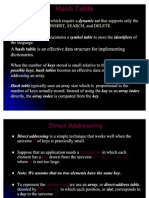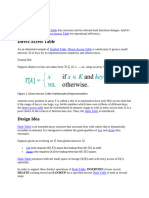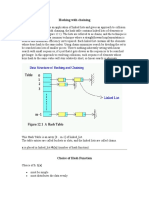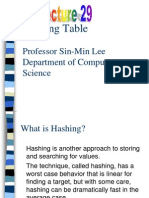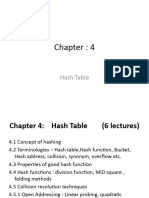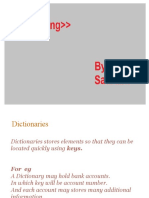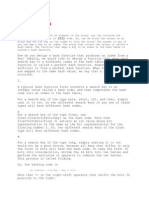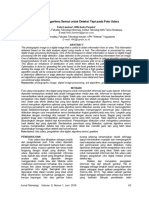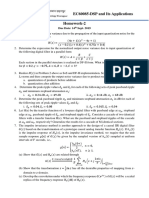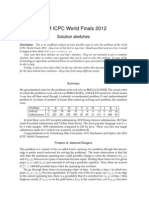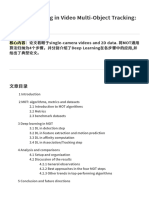CLRS Linked Lists
CLRS Linked Lists
Uploaded by
pulademotanCopyright:
Available Formats
CLRS Linked Lists
CLRS Linked Lists
Uploaded by
pulademotanOriginal Description:
Copyright
Available Formats
Share this document
Did you find this document useful?
Is this content inappropriate?
Copyright:
Available Formats
CLRS Linked Lists
CLRS Linked Lists
Uploaded by
pulademotanCopyright:
Available Formats
11.
2 Hash tables 257
T
U
(universe of keys)
K
(actual
keys)
k
1
k
2
k
3
k
4
k
5
k
6
k
7
k
8
k
1
k
2
k
3
k
4
k
5
k
6
k
7
k
8
Figure 11.3 Collision resolution by chaining. Each hash-table slot T j contains a linked list of
all the keys whose hash value is j. For example, h.k
1
/ = h.k
4
/ and h.k
5
/ = h.k
7
/ = h.k
2
/.
The linked list can be either singly or doubly linked; we show it as doubly linked because deletion is
faster that way.
There is one hitch: two keys may hash to the same slot. We call this situation
a collision. Fortunately, we have effective techniques for resolving the conict
created by collisions.
Of course, the ideal solution would be to avoid collisions altogether. We might
try to achieve this goal by choosing a suitable hash function h. One idea is to
make h appear to be random, thus avoiding collisions or at least minimizing
their number. The very term to hash, evoking images of random mixing and
chopping, captures the spirit of this approach. (Of course, a hash function h must be
deterministic in that a given input k should always produce the same output h.k/.)
Because [U[ > m, however, there must be at least two keys that have the same hash
value; avoiding collisions altogether is therefore impossible. Thus, while a well-
designed, random-looking hash function can minimize the number of collisions,
we still need a method for resolving the collisions that do occur.
The remainder of this section presents the simplest collision resolution tech-
nique, called chaining. Section 11.4 introduces an alternative method for resolving
collisions, called open addressing.
Collision resolution by chaining
In chaining, we place all the elements that hash to the same slot into the same
linked list, as Figure 11.3 shows. Slot j contains a pointer to the head of the list of
all stored elements that hash to j ; if there are no such elements, slot j contains NIL.
258 Chapter 11 Hash Tables
The dictionary operations on a hash table T are easy to implement when colli-
sions are resolved by chaining:
CHAINED-HASH-INSERT.T; x/
1 insert x at the head of list T h.x: key/
CHAINED-HASH-SEARCH.T; k/
1 search for an element with key k in list T h.k/
CHAINED-HASH-DELETE.T; x/
1 delete x from the list T h.x: key/
The worst-case running time for insertion is O.1/. The insertion procedure is fast
in part because it assumes that the element x being inserted is not already present in
the table; if necessary, we can check this assumption (at additional cost) by search-
ing for an element whose key is x: key before we insert. For searching, the worst-
case running time is proportional to the length of the list; we shall analyze this
operation more closely below. We can delete an element in O.1/ time if the lists
are doubly linked, as Figure 11.3 depicts. (Note that CHAINED-HASH-DELETE
takes as input an element x and not its key k, so that we dont have to search for x
rst. If the hash table supports deletion, then its linked lists should be doubly linked
so that we can delete an item quickly. If the lists were only singly linked, then to
delete element x, we would rst have to nd x in the list T h.x: key/ so that we
could update the next attribute of xs predecessor. With singly linked lists, both
deletion and searching would have the same asymptotic running times.)
Analysis of hashing with chaining
How well does hashing with chaining perform? In particular, how long does it take
to search for an element with a given key?
Given a hash table T with m slots that stores n elements, we dene the load
factor for T as n=m, that is, the average number of elements stored in a chain.
Our analysis will be in terms of , which can be less than, equal to, or greater
than 1.
The worst-case behavior of hashing with chaining is terrible: all n keys hash
to the same slot, creating a list of length n. The worst-case time for searching is
thus .n/ plus the time to compute the hash functionno better than if we used
one linked list for all the elements. Clearly, we do not use hash tables for their
worst-case performance. (Perfect hashing, described in Section 11.5, does provide
good worst-case performance when the set of keys is static, however.)
The average-case performance of hashing depends on how well the hash func-
tion h distributes the set of keys to be stored among the m slots, on the average.
11.2 Hash tables 259
Section 11.3 discusses these issues, but for now we shall assume that any given
element is equally likely to hash into any of the m slots, independently of where
any other element has hashed to. We call this the assumption of simple uniform
hashing.
For j = 0; 1; : : : ; m 1, let us denote the length of the list T j by n
j
, so that
n = n
0
n
1
n
m1
; (11.1)
and the expected value of n
j
is En
j
= = n=m.
We assume that O.1/ time sufces to compute the hash value h.k/, so that
the time required to search for an element with key k depends linearly on the
length n
h.k/
of the list T h.k/. Setting aside the O.1/ time required to compute
the hash function and to access slot h.k/, let us consider the expected number of
elements examined by the search algorithm, that is, the number of elements in the
list T h.k/ that the algorithm checks to see whether any have a key equal to k. We
shall consider two cases. In the rst, the search is unsuccessful: no element in the
table has key k. In the second, the search successfully nds an element with key k.
Theorem 11.1
In a hash table in which collisions are resolved by chaining, an unsuccessful search
takes average-case time .1/, under the assumption of simple uniform hashing.
Proof Under the assumption of simple uniform hashing, any key k not already
stored in the table is equally likely to hash to any of the m slots. The expected time
to search unsuccessfully for a key k is the expected time to search to the end of
list T h.k/, which has expected length En
h.k/
= . Thus, the expected number
of elements examined in an unsuccessful search is , and the total time required
(including the time for computing h.k/) is .1 /.
The situation for a successful search is slightly different, since each list is not
equally likely to be searched. Instead, the probability that a list is searched is pro-
portional to the number of elements it contains. Nonetheless, the expected search
time still turns out to be .1 /.
Theorem 11.2
In a hash table in which collisions are resolved by chaining, a successful search
takes average-case time .1/, under the assumption of simple uniform hashing.
Proof We assume that the element being searched for is equally likely to be any
of the n elements stored in the table. The number of elements examined during a
successful search for an element x is one more than the number of elements that
260 Chapter 11 Hash Tables
appear before x in xs list. Because new elements are placed at the front of the
list, elements before x in the list were all inserted after x was inserted. To nd
the expected number of elements examined, we take the average, over the n ele-
ments x in the table, of 1 plus the expected number of elements added to xs list
after x was added to the list. Let x
i
denote the i th element inserted into the ta-
ble, for i = 1; 2; : : : ; n, and let k
i
= x
i
: key. For keys k
i
and k
j
, we dene the
indicator random variable X
ij
= I {h.k
i
/ = h.k
j
/]. Under the assumption of sim-
ple uniform hashing, we have Pr {h.k
i
/ = h.k
j
/] = 1=m, and so by Lemma 5.1,
EX
ij
= 1=m. Thus, the expected number of elements examined in a successful
search is
E
"
1
n
n
X
i D1
1
n
X
jDi C1
X
ij
!#
=
1
n
n
X
i D1
1
n
X
jDi C1
EX
ij
!
(by linearity of expectation)
=
1
n
n
X
i D1
1
n
X
jDi C1
1
m
!
= 1
1
nm
n
X
i D1
.n i /
= 1
1
nm
n
X
i D1
n
n
X
i D1
i
!
= 1
1
nm
n
2
n.n 1/
2
(by equation (A.1))
= 1
n 1
2m
= 1
2n
:
Thus, the total time required for a successful search (including the time for com-
puting the hash function) is .2 =2 =2n/ = .1 /.
What does this analysis mean? If the number of hash-table slots is at least pro-
portional to the number of elements in the table, we have n = O.m/ and, con-
sequently, = n=m = O.m/=m = O.1/. Thus, searching takes constant time
on average. Since insertion takes O.1/ worst-case time and deletion takes O.1/
worst-case time when the lists are doubly linked, we can support all dictionary
operations in O.1/ time on average.
11.2 Hash tables 261
Exercises
11.2-1
Suppose we use a hash function h to hash n distinct keys into an array T of
length m. Assuming simple uniform hashing, what is the expected number of
collisions? More precisely, what is the expected cardinality of {{k; l] : k = l and
h.k/ = h.l/]?
11.2-2
Demonstrate what happens when we insert the keys 5; 28; 19; 15; 20; 33; 12; 17; 10
into a hash table with collisions resolved by chaining. Let the table have 9 slots,
and let the hash function be h.k/ = k mod 9.
11.2-3
Professor Marley hypothesizes that he can obtain substantial performance gains by
modifying the chaining scheme to keep each list in sorted order. How does the pro-
fessors modication affect the running time for successful searches, unsuccessful
searches, insertions, and deletions?
11.2-4
Suggest how to allocate and deallocate storage for elements within the hash table
itself by linking all unused slots into a free list. Assume that one slot can store
a ag and either one element plus a pointer or two pointers. All dictionary and
free-list operations should run in O.1/ expected time. Does the free list need to be
doubly linked, or does a singly linked free list sufce?
11.2-5
Suppose that we are storing a set of n keys into a hash table of size m. Show that if
the keys are drawn from a universe U with [U[ > nm, then U has a subset of size n
consisting of keys that all hash to the same slot, so that the worst-case searching
time for hashing with chaining is .n/.
11.2-6
Suppose we have stored n keys in a hash table of size m, with collisions resolved by
chaining, and that we know the length of each chain, including the length L of the
longest chain. Describe a procedure that selects a key uniformly at random from
among the keys in the hash table and returns it in expected time O.L .1 1=//.
262 Chapter 11 Hash Tables
11.3 Hash functions
In this section, we discuss some issues regarding the design of good hash functions
and then present three schemes for their creation. Two of the schemes, hashing by
division and hashing by multiplication, are heuristic in nature, whereas the third
scheme, universal hashing, uses randomization to provide provably good perfor-
mance.
What makes a good hash function?
A good hash function satises (approximately) the assumption of simple uniform
hashing: each key is equally likely to hash to any of the m slots, independently of
where any other key has hashed to. Unfortunately, we typically have no way to
check this condition, since we rarely know the probability distribution from which
the keys are drawn. Moreover, the keys might not be drawn independently.
Occasionally we do know the distribution. For example, if we know that the
keys are random real numbers k independently and uniformly distributed in the
range 0 _ k < 1, then the hash function
h.k/ = ]km
satises the condition of simple uniform hashing.
In practice, we can often employ heuristic techniques to create a hash function
that performs well. Qualitative information about the distribution of keys may be
useful in this design process. For example, consider a compilers symbol table, in
which the keys are character strings representing identiers in a program. Closely
related symbols, such as pt and pts, often occur in the same program. A good
hash function would minimize the chance that such variants hash to the same slot.
A good approach derives the hash value in a way that we expect to be indepen-
dent of any patterns that might exist in the data. For example, the division method
(discussed in Section 11.3.1) computes the hash value as the remainder when the
key is divided by a specied prime number. This method frequently gives good
results, assuming that we choose a prime number that is unrelated to any patterns
in the distribution of keys.
Finally, we note that some applications of hash functions might require stronger
properties than are provided by simple uniform hashing. For example, we might
want keys that are close in some sense to yield hash values that are far apart.
(This property is especially desirable when we are using linear probing, dened in
Section 11.4.) Universal hashing, described in Section 11.3.3, often provides the
desired properties.
You might also like
- Daa Unit 3Document91 pagesDaa Unit 3Abhishek FfNo ratings yet
- Hash TableDocument31 pagesHash TableShubhashree SethNo ratings yet
- CDocument20 pagesCKhondoker Razzakul HaqueNo ratings yet
- Hashing: John Erol EvangelistaDocument38 pagesHashing: John Erol EvangelistaJohn Erol EvangelistaNo ratings yet
- Questions 11Document3 pagesQuestions 11test789000No ratings yet
- HashingDocument13 pagesHashingnawazubaidulrahmanNo ratings yet
- HashingDocument23 pagesHashingHarsimran KaurNo ratings yet
- Hash TablesDocument35 pagesHash TablesAshutosh KumarNo ratings yet
- Lecture 9Document20 pagesLecture 9Marimuthu MuthaiyanNo ratings yet
- Hash TableDocument4 pagesHash Tablesara.lu.9210No ratings yet
- Hashing With ChainingDocument5 pagesHashing With ChainingsNo ratings yet
- Lec 11 Hash TableDocument43 pagesLec 11 Hash Tablecoco finaNo ratings yet
- 12 HashingDocument9 pages12 Hashingltl9999No ratings yet
- C10 - HashingDocument11 pagesC10 - HashingSpoorthi SuvarnaNo ratings yet
- Theory PDFDocument18 pagesTheory PDFNibedan PalNo ratings yet
- Unit1 Notes ADSDocument15 pagesUnit1 Notes ADSabhipatel876tNo ratings yet
- NITR 2 CuckooHashingDocument16 pagesNITR 2 CuckooHashingkidzee jankipuramNo ratings yet
- Introduction To Algorithms, Recitation 4Document9 pagesIntroduction To Algorithms, Recitation 4TomNo ratings yet
- Unit-5 2Document9 pagesUnit-5 2ramketha07No ratings yet
- Topic 1: Hashing - Introduction: Hashing Is A Method of Storing and Retrieving Data From A Database EfficientlyDocument31 pagesTopic 1: Hashing - Introduction: Hashing Is A Method of Storing and Retrieving Data From A Database EfficientlyĐhîřåj ŠähNo ratings yet
- Week13 1Document16 pagesWeek13 1tanushaNo ratings yet
- Hashing: Why We Need Hashing?Document22 pagesHashing: Why We Need Hashing?sri aknthNo ratings yet
- HashingDocument41 pagesHashinggolug971847No ratings yet
- Overview of Hash TablesDocument4 pagesOverview of Hash TablessadsdaNo ratings yet
- Ads-Unit IDocument16 pagesAds-Unit Irajasekharv86No ratings yet
- 03 HashingDocument21 pages03 HashingMirza AbdullaNo ratings yet
- CS 561, Lecture 2: Randomization in Data Structures: Jared Saia University of New MexicoDocument46 pagesCS 561, Lecture 2: Randomization in Data Structures: Jared Saia University of New MexicoΑλέξανδρος ΓεωργίουNo ratings yet
- Hashing SlideDocument16 pagesHashing Slidesdsourav713No ratings yet
- 10 DictionariesDocument11 pages10 DictionariesBrandy HydeNo ratings yet
- Hash FunctionsDocument60 pagesHash FunctionsArmin M KardovicNo ratings yet
- Mca-4 MC0080 IDocument15 pagesMca-4 MC0080 ISriram ChakrapaniNo ratings yet
- File Organization HashingDocument23 pagesFile Organization Hashingshifter.exeNo ratings yet
- Hash Tables: Map Dictionary Key "Address."Document16 pagesHash Tables: Map Dictionary Key "Address."ManstallNo ratings yet
- Hash Table: Didih Rizki ChandranegaraDocument33 pagesHash Table: Didih Rizki Chandranegaraset ryzenNo ratings yet
- Unit 5Document6 pagesUnit 5new bornNo ratings yet
- Unique Permutation Hashing: Shlomi Dolev Limor Lahiani Yinnon Haviv May 19, 2009Document11 pagesUnique Permutation Hashing: Shlomi Dolev Limor Lahiani Yinnon Haviv May 19, 2009Dinh Hoang OanhNo ratings yet
- CH 4 Hash TableDocument20 pagesCH 4 Hash TableKomal RathodNo ratings yet
- Lecture Notes On Hash Tables: 15-122: Principles of Imperative Computation Frank Pfenning, Rob Simmons February 28, 2013Document7 pagesLecture Notes On Hash Tables: 15-122: Principles of Imperative Computation Frank Pfenning, Rob Simmons February 28, 2013Munavalli Matt K SNo ratings yet
- HashingDocument9 pagesHashingmitudrudutta72No ratings yet
- Hashing AlgorithmsDocument22 pagesHashing Algorithmskarwan.e.zindagi.00No ratings yet
- Hashing TechniquesDocument13 pagesHashing Techniqueskhushinj0304No ratings yet
- 11 - Hash TableDocument65 pages11 - Hash Tablekarar salameNo ratings yet
- HashingDocument12 pagesHashingpappulaurarockNo ratings yet
- UNIT V - HashingDocument20 pagesUNIT V - HashingVVMNo ratings yet
- Hashing and GraphsDocument28 pagesHashing and GraphsSravani VankayalaNo ratings yet
- Hashingppts 150618032137 Lva1 App6891Document30 pagesHashingppts 150618032137 Lva1 App6891Blessing MapadzaNo ratings yet
- Linked Lists, Arrays, Stacks and QueuesDocument7 pagesLinked Lists, Arrays, Stacks and QueuesdiptanshujainNo ratings yet
- c11 HashingDocument9 pagesc11 Hashinggowtham saiNo ratings yet
- CE2001 Algor Tutorial 3Document1 pageCE2001 Algor Tutorial 3Clark CareyNo ratings yet
- Dictionaries: SetsDocument92 pagesDictionaries: Sets22wh1a1231No ratings yet
- HASHINGDocument8 pagesHASHINGanujbhagat031No ratings yet
- Practice Set 4Document2 pagesPractice Set 4Emo CowsNo ratings yet
- Full Unit 6 Cse 205 (1)Document20 pagesFull Unit 6 Cse 205 (1)shyamcharan4444No ratings yet
- Hash TableDocument9 pagesHash TableMuzamil YousafNo ratings yet
- Chapter 28 Hashing: Hash Table. The Function That Maps A Key To An Index in The Hash Table IsDocument4 pagesChapter 28 Hashing: Hash Table. The Function That Maps A Key To An Index in The Hash Table IsrchambillaNo ratings yet
- 14 HashingDocument23 pages14 Hashingmu511ckNo ratings yet
- Hashing PDFDocument61 pagesHashing PDFImogenDyerNo ratings yet
- Binary SearchDocument1 pageBinary SearchMohammedFikryNo ratings yet
- HashingDocument10 pagesHashingLatif Siddiq SunnyNo ratings yet
- Optimal Binary Search Tree-1Document11 pagesOptimal Binary Search Tree-1KamiNo ratings yet
- Predicting Missing Items in A Shopping Cart Using Apriori AlgorithmDocument3 pagesPredicting Missing Items in A Shopping Cart Using Apriori AlgorithmVinay KumarNo ratings yet
- Turbo Codes For PCS Applications: AbstractDocument6 pagesTurbo Codes For PCS Applications: AbstractMudita ChandraNo ratings yet
- Pmso - Question BankDocument4 pagesPmso - Question BankdarshanNo ratings yet
- Transportation and Assignment ProblemDocument67 pagesTransportation and Assignment ProblemRovick TarifeNo ratings yet
- Admin Journal Manager 63 69 LiantoniDocument7 pagesAdmin Journal Manager 63 69 Liantonimuhtaufiq170602No ratings yet
- EC60085-DSP and Its Applications Homework-2: Due Date: 14 Sept. 2019Document2 pagesEC60085-DSP and Its Applications Homework-2: Due Date: 14 Sept. 2019harshitNo ratings yet
- Ancestor ProblemDocument3 pagesAncestor ProblemZaeem KhanNo ratings yet
- ACM ICPC Finals 2012 SolutionsDocument5 pagesACM ICPC Finals 2012 Solutionsbarunbasak1No ratings yet
- MATH2089 NM Lectures Topic4Document16 pagesMATH2089 NM Lectures Topic4mbjanjua35No ratings yet
- CSE 326: Data Structures Lecture #3 Analysis of Recursive AlgorithmsDocument18 pagesCSE 326: Data Structures Lecture #3 Analysis of Recursive Algorithmslini ickpnnNo ratings yet
- 《Deep Learning in Video Multi-Object Tracking A Survey》Document13 pages《Deep Learning in Video Multi-Object Tracking A Survey》by nickNo ratings yet
- Fisher Ratio EEGDocument4 pagesFisher Ratio EEGBudi SetyawanNo ratings yet
- 8 PuzzleDocument2 pages8 PuzzleJessie SethdavidNo ratings yet
- Discrete Cosine TransformDocument26 pagesDiscrete Cosine TransformDivanshu InsaNo ratings yet
- Lecture 5 PCMDocument38 pagesLecture 5 PCMSakawa BobNo ratings yet
- IMS Checklist 4 - Mod 3-1Document8 pagesIMS Checklist 4 - Mod 3-1Febin C.S.No ratings yet
- RLC Low-Pass Filter Design Tool - Result - 1000hz - Cut - OffDocument4 pagesRLC Low-Pass Filter Design Tool - Result - 1000hz - Cut - OffShrinath KannanNo ratings yet
- Unit IiDocument8 pagesUnit Iinikhilsinha789No ratings yet
- Appm 2007 Course Outline NumericsDocument2 pagesAppm 2007 Course Outline NumericsFanta CamaraNo ratings yet
- Vivek NTDocument45 pagesVivek NTvivekbourneNo ratings yet
- Exam 2 S 13 KeyDocument11 pagesExam 2 S 13 KeyZahraa TishreenNo ratings yet
- Ab Und AufzugDocument5 pagesAb Und AufzugelvagojpNo ratings yet
- Network Models: To Accompany by Render, Stair, and Hanna Power Point Slides Created by Brian PetersonDocument43 pagesNetwork Models: To Accompany by Render, Stair, and Hanna Power Point Slides Created by Brian PetersonBùi Đức NghịNo ratings yet
- Information Theory and CodingDocument2 pagesInformation Theory and CodingprafullaNo ratings yet
- Convolutional Codes PuncturingDocument13 pagesConvolutional Codes PuncturinghunterdlrNo ratings yet
- 5b Python Implementation of Decision TreeDocument7 pages5b Python Implementation of Decision Treeceyikep910No ratings yet
- FORM ReliabilityDocument2 pagesFORM ReliabilityLukusa BadimuenaNo ratings yet
- Study & Run All The Programs in Matlab & All Functions Also: List of ExperimentsDocument10 pagesStudy & Run All The Programs in Matlab & All Functions Also: List of Experimentsmayank5sajheNo ratings yet
- Experiment - 1: AIM: Write A Program To Implement QUICK SORTDocument24 pagesExperiment - 1: AIM: Write A Program To Implement QUICK SORTAshish SharmaNo ratings yet

